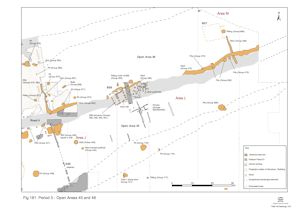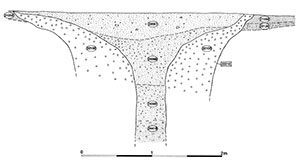
That part of Open Area 45 in front (east) of the temple precinct wall (mainly within Excavation Area J) is evidently kept clear of structures and is used in close association with the temple and its ritual activities (Figure 181). The eastward extent of this is not precisely determined, but the character of this area changes by Excavation Area L. The activity taking place in the eastern part (Excavation Areas L and M) is described in 'Central zone, Open Area 45 (east)' and seems to differ from that part closest to the temple.

A monumental post, as denoted by post-hole 21801 (Group 440), is erected outside the eastern temple precinct wall in Open Area 45. The post-hole is 1.15m in diameter with a central post-pipe of 0.33m diameter and is similar to, if smaller than, the monumental post-hole 5232 (Group 427 Period 4) previously inserted into the north-eastern corner of the temple precinct - and presumably still stands at this time.
The significance of this post is indicated by its location - 11m directly in front of the doorway of the eastern precinct wall (Structure 46) and ultimately aligned upon the entrance to the temple cella (Building 52). Its position would therefore seem to be integral to the temple complex. A coin (SF7694) of AD 273-4 and a mirror fragment (SF7693) may represent a foundation 'offering' within its tile and stone rubble-rich fill. The post is likely to be erected in the late 3rd century and to stand until the early/mid-4th century when it is removed and the pipe backfilled.
The siting of this post outside the precinct may suggest that religious rites are not held exclusively within the confines of the precinct but extend onto the gravel-surfaced area surrounding it.

It may be inferred from later 'pool' 22210 (Group 987 Period 6) that a well (Group 448) may be situated immediately north of the monumental post in Period 5 - or perhaps even earlier. Cut 22210 was only partially excavated but it is established that the lower part of the 3.5m diameter cut is packed with orange clay (?around a postulated wooden well shaft lining) - as is the case with other Roman wells at Heybridge (Figure 182). As a functioning well, this feature probably passes out of use by the late 3rd century. In disuse, its lining has presumably decayed and the clay construction backfill slumped to line a splayed erosion cone that, perhaps incidentally/opportunistically, continues in use as something like a votive pool.
Internet Archaeology is an open access journal based in the Department of Archaeology, University of York. Except where otherwise noted, content from this work may be used under the terms of the Creative Commons Attribution 3.0 (CC BY) Unported licence, which permits unrestricted use, distribution, and reproduction in any medium, provided that attribution to the author(s), the title of the work, the Internet Archaeology journal and the relevant URL/DOI are given.
Terms and Conditions | Legal Statements | Privacy Policy | Cookies Policy | Citing Internet Archaeology
Internet Archaeology content is preserved for the long term with the Archaeology Data Service. Help sustain and support open access publication by donating to our Open Access Archaeology Fund.